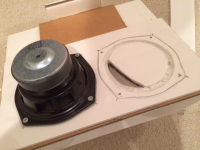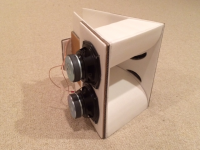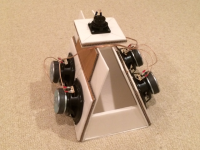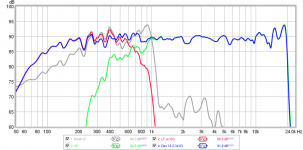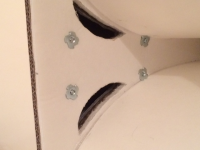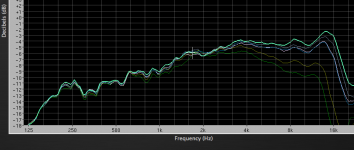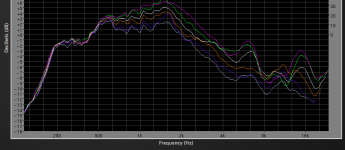You mean like how the mid/hi horn is in the mouth of the University Classic bass horn?


https://community.klipsch.com/index.php?/topic/146927-the-rebirth-of-the-university-classics/


https://community.klipsch.com/index.php?/topic/146927-the-rebirth-of-the-university-classics/
If I understand correctly, a conical horn has a variable flare rate (which is what makes the Synergy work as well as it does) and a traditional horn has a fixed flare rate.
That said, I wonder if a trad horn profile would give us more freedom in the port placement (keeping in mind the 1/4wl reflection and horn length for lf loading if needed) since the flare rate is already determined?
I also wonder if a trad profile would better satisfy the requirement that the mid taps into a circumference that's larger than the largest hf wl which is said to help "hide" the ports from the hf output. I could see that working - to an extent - with a horn that has increasing directivity but I don't buy it with a conical horn.
These are great questions, not wanting to do the hard math by hand, I just go into Akabak and stick the ports where they are practical or convenient and then run the sim to see how it looks. Generally, the placement of the mid or bass injection port exact location is not critical in the tractrix. I wonder if this is why it seems to not be critical. I can get it to blend almost anywhere with the proper time delay (yes, maybe DSP is the magic sauce?). Going with passive XO is another story.
You mean like how the mid/hi horn is in the mouth of the University Classic bass horn?


https://community.klipsch.com/index.php?/topic/146927-the-rebirth-of-the-university-classics/
Nah, more like half of russian wood pupett : a cube into a cube... like with the Sphere Speaker point source : the wider speaker radiates all around the mouth of the littliest ones !
Putt your littliest synergy horn in(side) the mouth of a bigger woof horn and you will see the woof can only radiates all around the mouth of the littliest horn. Basicly it's not a horn anymore for the woof but a shape of a horn. As the woof is at the Apex of the biggest horn (while the littliest horn is on the front of the large woof driver (in the axis)) : it needs its own sealed cabinet (or vented) like with the little sealed box of the 10F has itself !
Putt a cube around, like all did with synergy designs to hide the outsides walls of the subwoof horn and its sealed cabinet for the subwoof 15" or 18" driver : and you have a Synergy but with the sub in it... or exactly: around it ! Point source : or nearer than 2Pi as the frequencies involved are very low (<100 Hz).
Not so far than the University as this last is radiating around its littliest horn but on a larger width and towards the height (which has a roof, so a little like a sort of large mouth)!
(PS : I can smell from France that you will buy a MiniDSP module for FIR time correction at Christmass 🙂 )
Last edited:
I think I understand what you are saying but a cube with a annular channel around it for the woofer will be more like a slot loaded sub rather than a horn. As the horn requires some length to get bass gain. The Uni Classic above is 108dB sensitive and goes about 60Hz to 500Hz. With a slot loaded (albeit, annular slot), there is a limitation on upper bandwidth dictated by slot depth. It is quite low - circa 190Hz for 18in deep slot. Need to get up to 400Hz if you want a 2 way. But if using four smaller mid bass for 100Hz to 500Hz coverage the Russian nested doll sub can work.
No miniSHARC for me this Xmas.
No miniSHARC for me this Xmas.
Yes, sort of slot loaded as I writted : below 100 Hz 🙂,
Sort of U bafle with yiur trynergy inside... for more visual integration ! the synergy Inside manage the mid-bass range from 10F XO to around 100/150 Hz (= the Trynergy)... after the bass horn manage the low end... (= the Trynergy Inside a cubic horn) ! (More in depth than in width like the University is.... if you prefer
I would like to see a polar map of a University...
Sort of U bafle with yiur trynergy inside... for more visual integration ! the synergy Inside manage the mid-bass range from 10F XO to around 100/150 Hz (= the Trynergy)... after the bass horn manage the low end... (= the Trynergy Inside a cubic horn) ! (More in depth than in width like the University is.... if you prefer
I would like to see a polar map of a University...
Last edited:
Eldam,I would like to see a polar map of a University...
You can approximate a polar map of the University Classic by spilling a plate of spaghetti on to a piece of lined paper 😉.
Art
To be fair, up to 500Hz it's probably not all that bad as all the directivity lobing and beaming occur at higher frequencies?
Parallel side walls with a CobraFlex horn stuck in the middle is OK for the barker for midway rides at the fairgrounds, but ain't going to produce an even response below 500 Hz on any axis.To be fair, up to 500Hz it's probably not all that bad as all the directivity lobing and beaming occur at higher frequencies?
The game should be to keep the subjective dynamic and fastness of the bass cabinets below the the XO of the synergy horn... <100/150 Hz... not 500 Hz !
Sloted bass cabinet seems not so bad at this game if we take into consideration one can't have a W Onken at home !
thermo moddeling could be fun : Something less rigid than the too thin plastic like the cheapest horns are !
Maybe Mister Danley would not care if Seos grup will make such a horn but not drilled for mid-woofs port injections ? It will stay DIY as the horn owner would have to drill himself the ports (while there will be in the same time plane shape behind the horn to attach mid-woofs units ) ?
Sloted bass cabinet seems not so bad at this game if we take into consideration one can't have a W Onken at home !
thermo moddeling could be fun : Something less rigid than the too thin plastic like the cheapest horns are !
Maybe Mister Danley would not care if Seos grup will make such a horn but not drilled for mid-woofs port injections ? It will stay DIY as the horn owner would have to drill himself the ports (while there will be in the same time plane shape behind the horn to attach mid-woofs units ) ?
Last edited:
A low cost molded plastic tractrix similar in size to my micro Trynergy at 8.5in X 13in and 2in throat (round to square transition) would be very cool.
There was a thread where Martinsson took a commercial JBL 2386 horn (big 40x20 deg bi radial - appears to be beaucoup bux though, pardon my French Eldam ) and stuck a 2in Tang Band on it with similar success.
http://www.sound-image.com/wp-content/uploads/JBL_2386.pdf
http://www.diyaudio.com/forums/full-range/205146-2-madness-hornloading-tb-w2-803sm.html
I should take a clue and try his passive EQ circuit

And got this:

These JBL's can be had for cheap on used market though and with bass injection holes cut in them can make a suitable basis for a Brynergy (biradial-synergy). These are spec'd to horn load down to about 350Hz so seems perfect for adding bass injection ports.
Thanks for reminding me of this thread Eldam. A quick search shows that 29 used units of this bi radial horn are available on East Coast of US for $35 ea!
I may have to buy a pair! 🙂 not so beaucoup bux anymore 🙂
There was a thread where Martinsson took a commercial JBL 2386 horn (big 40x20 deg bi radial - appears to be beaucoup bux though, pardon my French Eldam ) and stuck a 2in Tang Band on it with similar success.
http://www.sound-image.com/wp-content/uploads/JBL_2386.pdf
http://www.diyaudio.com/forums/full-range/205146-2-madness-hornloading-tb-w2-803sm.html
I should take a clue and try his passive EQ circuit

And got this:

These JBL's can be had for cheap on used market though and with bass injection holes cut in them can make a suitable basis for a Brynergy (biradial-synergy). These are spec'd to horn load down to about 350Hz so seems perfect for adding bass injection ports.
Thanks for reminding me of this thread Eldam. A quick search shows that 29 used units of this bi radial horn are available on East Coast of US for $35 ea!
I may have to buy a pair! 🙂 not so beaucoup bux anymore 🙂
Last edited:
I was thinking of cheaper profiles like the diysound group are making ! But better quality than the first price because of damping !
JBL is no cheap, even too beaucoup much bux on second hand yet and very US markett only...(maybe Japan as well).
A 1.4" exit could suffice for the 2" cone surface of the 10F ?
JBL is no cheap, even too beaucoup much bux on second hand yet and very US markett only...(maybe Japan as well).
A 1.4" exit could suffice for the 2" cone surface of the 10F ?
Last edited:
I was thinking of cheaper profiles like the diysound group are making ! But better quality than the first price because of damping !
JBL is no cheap, even too beaucoup much bux on second hand yet and very US markett only...(maybe Japan as well).
A 1.4" exit could suffice for the 2" cone surface of the 10F ?
We were around that JBL horn around post 500 in this thread company P-Audio Europe make a clone PH-2380 at very low cost inside EU zone, also their PH-2723 could maybe make micro version, PH-2723 has most flat top and bottom and could maybe hold 4x 6FE100

Horns in stock at UK dealer BLUE ARAN, 6FE100 needs request:
P-Audio :: P-Audio PH-2380 2" Throat Horn Flare 90 x 40 Dispersion 22.68 IN STOCK (17 Dec 2015)#
P-Audio PH-2723 2" Horn Flare 60 x 40 Dispersion 24.95 IN STOCK (17 Dec 2015)#
Faital Pro :: Faital Pro 6FE100 6" Speaker Driver 100 W 8 Ohm 23.21
It's a good tip, thanks BYRTT
Let me a little more time to finish my foam version of the Trynergy to know if it deserve a more solid built (without lost in relation to the foam or no Worth to swap !)
I plan more 2 x 10" per channel as I don't have access to the PE good sells ! I assume 2 x 80 euros per side for the B&C 10CL51 is easier to drive, glue more to the needed efficienty...
The "problem" with synergy design is the cones should be near the ports : no tunnels seem possible between the horn ports towards a plane piece of wood where the drivers could radiate from ! So it's very not easy to add mid-woof to a horn not designed for this Synergy needs...🙁
Did you make a Trynergy yourself ?
@ X : you will have pain with a Brynergy (what a brain energy !) to get as low as 500 Hz for the crossing point between horizontal and vertical radiation pattern if I understood a little what Bi-radiall of Iwata are ! Or it calls you a huge Brynergy ! Larger than the Trynergy ! Not easy to make a Bi-radial à la TH-4001 : expansion must be linear then exponential... for the curved top&bottom walls
Let me a little more time to finish my foam version of the Trynergy to know if it deserve a more solid built (without lost in relation to the foam or no Worth to swap !)
I plan more 2 x 10" per channel as I don't have access to the PE good sells ! I assume 2 x 80 euros per side for the B&C 10CL51 is easier to drive, glue more to the needed efficienty...
The "problem" with synergy design is the cones should be near the ports : no tunnels seem possible between the horn ports towards a plane piece of wood where the drivers could radiate from ! So it's very not easy to add mid-woof to a horn not designed for this Synergy needs...🙁
Did you make a Trynergy yourself ?
@ X : you will have pain with a Brynergy (what a brain energy !) to get as low as 500 Hz for the crossing point between horizontal and vertical radiation pattern if I understood a little what Bi-radiall of Iwata are ! Or it calls you a huge Brynergy ! Larger than the Trynergy ! Not easy to make a Bi-radial à la TH-4001 : expansion must be linear then exponential... for the curved top&bottom walls
Last edited:
It's a good tip, thanks BYRTT
The "problem" with synergy design is the cones should be near the ports : no tunnels seem possible between the horn ports towards a plane piece of wood where the drivers could radiate from ! So it's very not easy to add mid-woof to a horn not designed for this Synergy needs...🙁
Yes, how to best incorporate mid bass drivers over the injection ports has had me wondering a bit to.
Woofer installation
I found some time to install the four 5.25in buyout woofers today. Detail shows how ring of foam core removed to provide clearance for rubber surround:
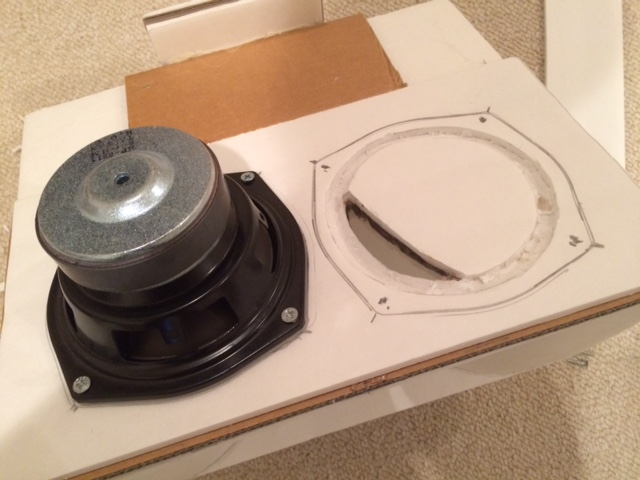
micro Trynergy with woofers installed:
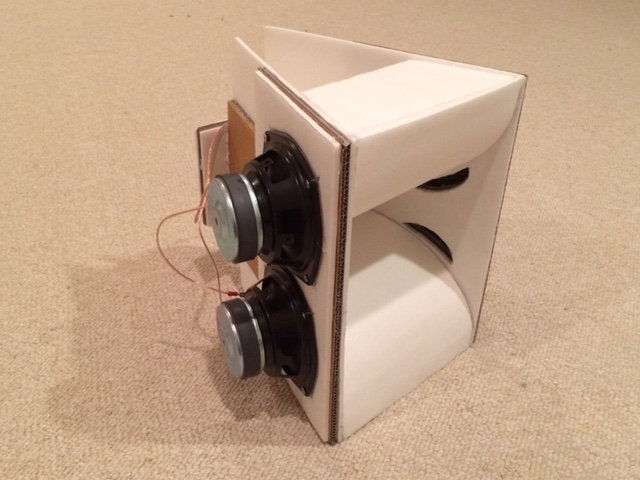
Rear view showing full range W2-852SH and woofers:
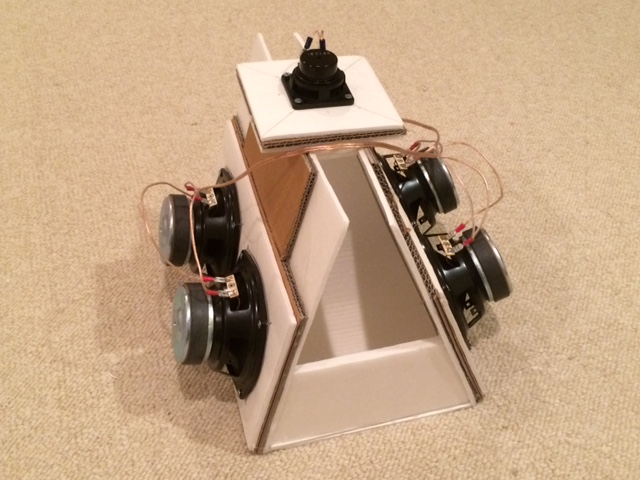
Very rough attempt at EQ'ing open baffle woofers (raw is grey) to hear what it may sound like. EQ'd woofer response is red, shows great upper frequency extension so I should be able to XO to fullrange driver no problems. Even without BR or sealed rear chamber, drivers can hit 100Hz with EQ, but the distortion is higher.
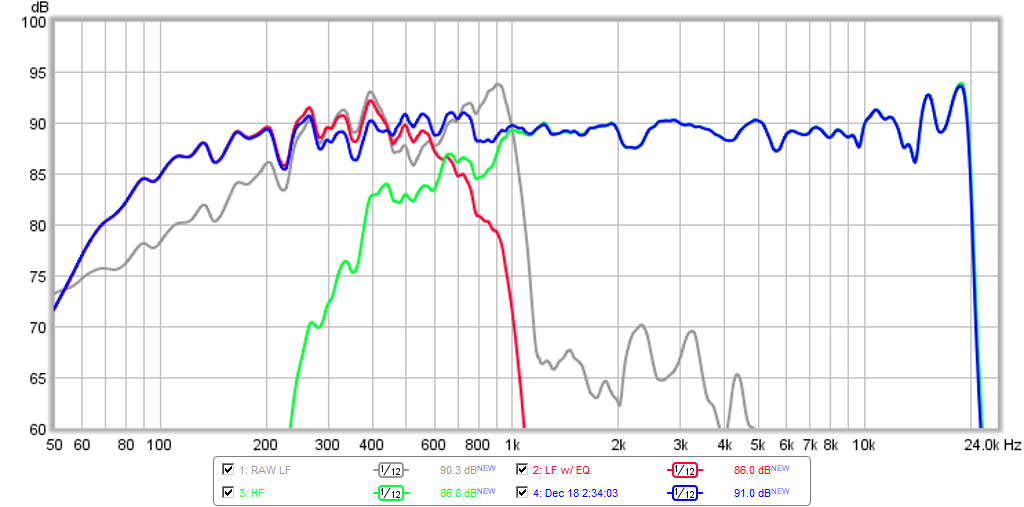
The bandpass injection ports in this case are good for almost 1kHz. I need to build a pink XPS foam box to house the whole thing and turn the woofers into a sealed back chamber. Although still contemplating a BR port version.
I found some time to install the four 5.25in buyout woofers today. Detail shows how ring of foam core removed to provide clearance for rubber surround:

micro Trynergy with woofers installed:

Rear view showing full range W2-852SH and woofers:

Very rough attempt at EQ'ing open baffle woofers (raw is grey) to hear what it may sound like. EQ'd woofer response is red, shows great upper frequency extension so I should be able to XO to fullrange driver no problems. Even without BR or sealed rear chamber, drivers can hit 100Hz with EQ, but the distortion is higher.

The bandpass injection ports in this case are good for almost 1kHz. I need to build a pink XPS foam box to house the whole thing and turn the woofers into a sealed back chamber. Although still contemplating a BR port version.
Attachments
Last edited:
Sound Clips of micro Trynergy with open back woofers
I fixed a small buzzing problem as the screws holding the woofers were just not getting enough grip on the triple layer cardboard. I used T-nuts on the inside surface of the horn and these hold really tight.
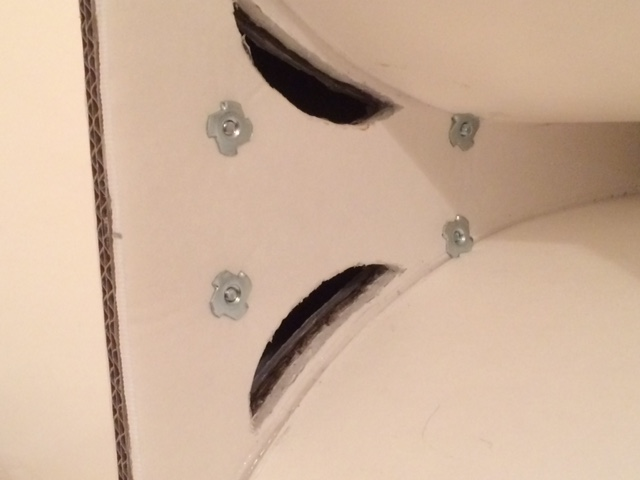
I have not had a chance to make the external enclosure for the micro Trynergy yet, but did some listening and it sounds very detailed. Of course, with no bass below 100Hz it sounds a bit thin but listen to the midrange in the voice and the highs in the cymbals. The time alignment also appears to be pretty good. Anyhow, these are just very preliminary sound clips for those anxious to hear. The overall sensitivity is set by the four woofers so is currently around 94 dB so these can play pretty loud despite the small form factor.
Change .asc extension to .mp3 to listen.
I fixed a small buzzing problem as the screws holding the woofers were just not getting enough grip on the triple layer cardboard. I used T-nuts on the inside surface of the horn and these hold really tight.

I have not had a chance to make the external enclosure for the micro Trynergy yet, but did some listening and it sounds very detailed. Of course, with no bass below 100Hz it sounds a bit thin but listen to the midrange in the voice and the highs in the cymbals. The time alignment also appears to be pretty good. Anyhow, these are just very preliminary sound clips for those anxious to hear. The overall sensitivity is set by the four woofers so is currently around 94 dB so these can play pretty loud despite the small form factor.
Change .asc extension to .mp3 to listen.
Attachments
Last edited:
I was thinking of cheaper profiles like the diysound group are making ! But better quality than the first price because of damping !
JBL is no cheap, even too beaucoup much bux on second hand yet and very US markett only...(maybe Japan as well).
A 1.4" exit could suffice for the 2" cone surface of the 10F ?
tried the 10F/8424 in the micro Trynergy with 1.4in x 1.4in square throat. It was not happy - there was severe cancellation in the highs compared to the smaller 2in Tang Band - it may have to do with the 3.5in dia wide cavity created behind the throat and how that has different path lengths to the throat. All this may be improved with a good phase plug as we know there are 3in dia compression drivers out there that don't have this problem feeding into a 1.4in throat horn.
I was thinking of cheaper profiles like the diysound group are making ! But better quality than the first price because of damping !
I've been waiting for a couple of the larger SEOS waveguides to try this with, but Erich seems to be behind on things, I haven't heard back from him since ordering them a few weeks ago. Of course there are drivers that can already drive a SEOS over its entire directivity-control range, but getting the lower midrange frequencies to emanate from the same central point while staying close enough to the higher stuff is the goal here.
A 3" diaphragm compression driver has enough BL (20+) to "push" the air through a 10/1 phase plug, retaining the HF response, though still falling at 6 dB per octave above the mass break point around 3000 Hz.tried the 10F/8424 in the micro Trynergy with 1.4in x 1.4in square throat. It was not happy - there was severe cancellation in the highs compared to the smaller 2in Tang Band - it may have to do with the 3.5in dia wide cavity created behind the throat and how that has different path lengths to the throat. All this may be improved with a good phase plug as we know there are 3in dia compression drivers out there that don't have this problem feeding into a 1.4in throat horn.
Putting in a phase plug in the low BL cone driver will just result in a massive HF loss, and air compression distortion trying to make up the loss.
Tests a few days ago determined that the native HF dispersion of the 3.5" Tymphony TC9FD-18-08 is around -11dB at 16kHz at 25 degrees off axis.
The narrow HF dispersion results in the on axis rise Using a 45 x (approximately) 30 degree conical horn with a 2 3/8" x 2 3/8" square throat, the frequency response remained smooth, other than on axis +3 dB peaks at 6 kHz and 15 kHz, and dispersion remained uniform out to 25 degree off axis, only 8 dB down from on axis at 16kHz, an improvement compared to the native response. The 6 dB per octave mass break drop starts at 1600 Hz, about an octave lower than a typical compression driver.
Response at 16 kHz on the horn has perhaps 1 dB gain over the direct radiator (no baffle, 1 liter sealed chamber), maximum gain of about 12 dB at 1.6 kHz compared to the sealed direct radiator.
The screen shots below show on axis response, followed by 5,10,15,20 and 25 degrees off axis.
Art
Attachments
Last edited:
I've been waiting for a couple of the larger SEOS waveguides to try this with, but Erich seems to be behind on things, I haven't heard back from him since ordering them a few weeks ago. Of course there are drivers that can already drive a SEOS over its entire directivity-control range, but getting the lower midrange frequencies to emanate from the same central point while staying close enough to the higher stuff is the goal here.
Please let us know how this works out.....detailed measurements would be cool 😉
- Home
- Loudspeakers
- Multi-Way
- Presenting the Trynergy - a full range tractrix synergy.
